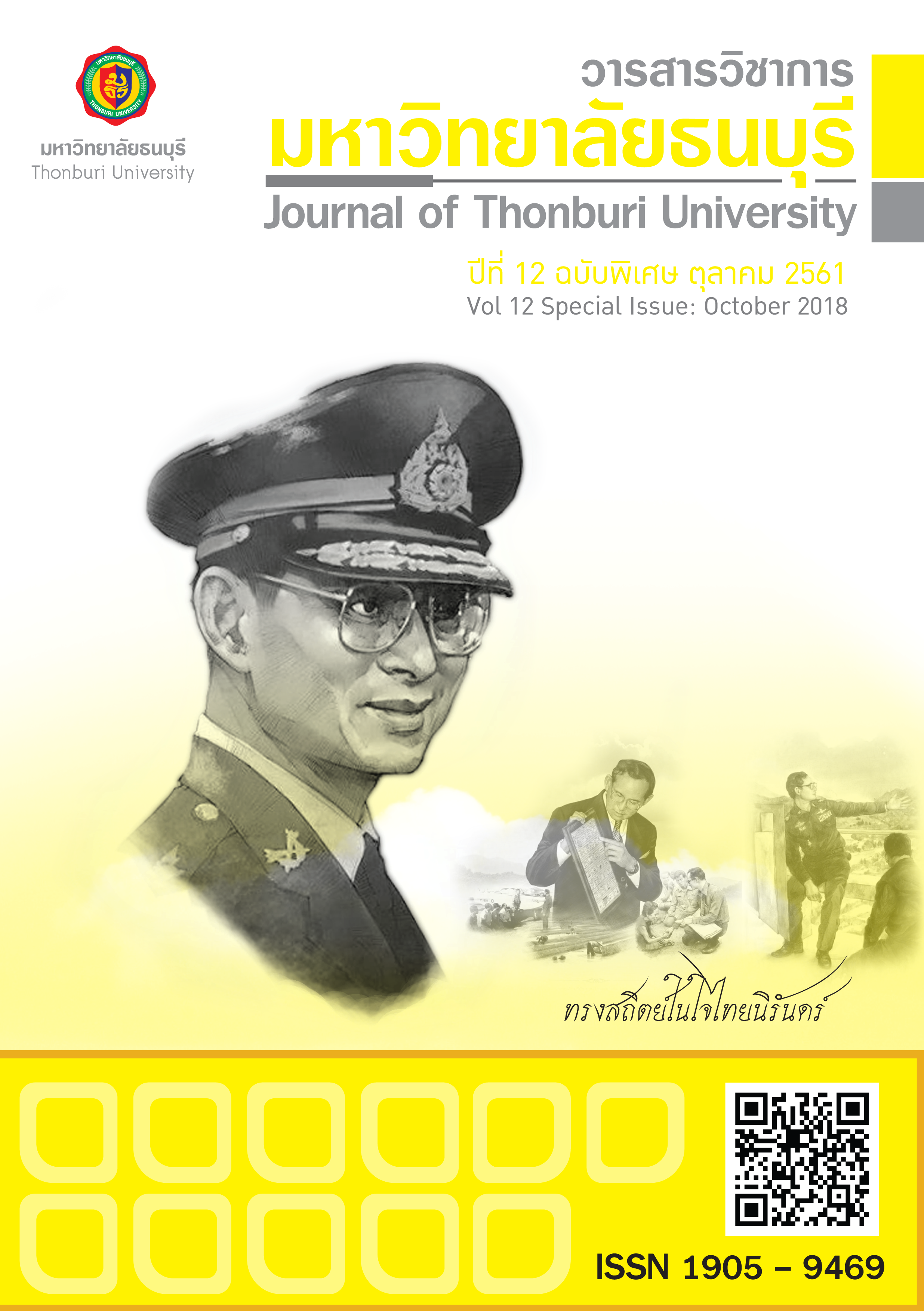A REVIEW Of EDUCATIONAL COMMUNICATION MODEL A PRACTICAL TEACHING IN THE THAI CLASSROOM GUIDE
คำสำคัญ:
รูปแบบการสื่อสารเพื่อการเรียนรู้ การเรียนการสอนในประเทศไทย, การสื่อสารในห้องเรียน, การสื่อสารข้ามวัฒนธรรม, นวัตกรรมการเรียนรู้และเทคโนโลยีบทคัดย่อ
บทคัดย่อ
การสื่อสารเพื่อการศึกษาคือกระบวนการแลกเปลี่ยนข้อเท็จจริง ความคิดเห็นและวิธีการเรียนรู้ ซึ่งบุคคลหรือองค์กรมีส่วนร่วมในการแลกเปลี่ยนเรียนรู้ซึ่งกันและกัน อย่างไรก็ตามความสัมพันธ์ระหว่างการสื่อสารในห้องเรียนและผลสัมฤทธิ์ทางการเรียนของผู้เรียนนั้นมีความเกี่ยวข้องกันอย่างมีนัยสำคัญ ซึ่งบทความนี้นำเสนอวิธีการปรับใช้กระบวนการเรียนรู้และการเรียนการสอนเพื่อให้เกิดการสื่อสารโต้ตอบแบบสองทาง ซึ่งจะส่งผลดีกับผู้เรียนและกระบวนการเรียนการสอนได้อย่างมีประสิทธิภาพ ซึ่งแน่นอนว่าไม่สามารถสรุปได้ว่าความสำเร็จของการเรียนรู้มาจากการสื่อสารทั้งหมด แต่ต้องยอมรับว่าการสื่อสารที่มีประสิทธิภาพนั้นมีส่วนอย่างมากในการสร้างความสำเร็จในการเรียนรู้ โดยรูปแบบการสื่อสารเพื่อการเรียนรู้ (The Educational Communication Model): เป็นตัวอย่างรูปแบบกระบวนการการสื่อสารเพื่อการเรียนรู้ที่ประสบความสำเร็จระหว่างผู้สอนและผู้เรียน ซึ่งนับว่าเป็นเงื่อนไขสำคัญที่ส่งผลโดยตรงต่อผลสัมฤทธิ์ทางการเรียนของผู้เรียน ในยุคที่มีความหลายหลายทางวัฒนธรรมและมีความแตกต่างกันระหว่างบุคคล ซึ่งจะทำให้ผู้สอนสามารถบริหารจัดการการเรียนการสอน โดยทราบถึงความต้องการของผู้เรียน ทำให้ผู้สอนสามารถสอนได้อย่างเหมาะสมและสร้างบรรยากาศที่ดีในการแลกเปลี่ยนเรียนรู้ โดยบทความนี้จะเป็นการนำเสนอรูปแบบการสื่อสารเพื่อการเรียนรู้ที่ประกอบด้วยครูผู้สอน (sources) การสื่อสาร (encoding) และผู้เรียน (receivers) โดยเป็นการสรุปและเสนอแนะการสื่อสารในห้องเรียนให้กับผู้สอนโดยเน้นกระบวนทางนวัตกรรมการเรียนรู้
คำสำคัญ: รูปแบบการสื่อสารเพื่อการเรียนรู้ การเรียนการสอนในประเทศไทย, การสื่อสารในห้องเรียน, การสื่อสารข้ามวัฒนธรรม, นวัตกรรมการเรียนรู้และเทคโนโลยี
References
Barnlund, D. C. (2008). A transactional model of communication. In. C. D. Mortensen (Eds.), Communication theory. 2nded. (pp 47-57). New Brunswick, New Jersey: Transaction.
Baumgart, N., & Halse, C. (1999). Approaches to learning across cultures: The role of assessment. Assessment in Education: Principles, Policy & Practice, 6 (3): 321-339.
David Berlo. (1960). Process of Communication: An Introduction to Theory and Practice. Cengage Learning. Flannery, T. J. (1995). Developing lesson plans. Fire Engineering, 148: 16-18.
Gravois, J. (2005). Teach impediment. The Chronicle of Higher Education, 51 (31): A10.
Gudykunst, W. B., & Kim, Y. Y. (1992). Communicating with strangers: An approach to intercultural communication. 2nded. New York: McGraw-Hill.
Hofstede, G. (2005). Cultures and organizations: Software of the mind. New York: McGraw Hill.
Knutson, T. J. (2004). Thai cultural values: Smiles and sawasdee as implications for intercultural communication effectiveness. Journal of Intercultural Communication Research, 33 (3): 147-157.
McCroskey, J. C., Richmond, V. L., & McCroskey, L. L. (2006). Introduction to communication in the classroom: The role of communication in teaching and training. Boston: Pearson.
Phondee, Samran. (2016). A model of setting thonburi-learning center. Journal of Thonburi University. 10(21): 127.
Settachai Chaisanit, Apichai Tra-ngansri, Luddawan Meeanan and Chiraphorn Chomyim. (2015). Learning Culture, Norms and Values through Interactive Simulation Learning Environment. 4th International Conference on Education and E-Learning (ICEEL). Hong Kong. November 28, 2015.
Settachai Chaisanit, Punchanit Phangphol, Chiraphorn Chomyim, Napatwadee Sangboonnum Hongthong and Nawarat Kamsiang. (2017). Problem Conditions in Learning Media and Instructional Technology of Anubanchonburi School. SPUC International Conference 2017 Research and Creative Solution for AEC Identities for Thailand Development 4.0. Chonburi, Thailand. June 29, 2017.
Settachai Chaisanit, Orawan Riwsawai and Apichai Trangansri. (2014). Design and Development of an Educational 3D Virtual Reality into Language Learning. International Conference on Advanced Engineering Technology (ICAET 2014). Incheon, South Korea.
Shannon, C. E. A (1949). Mathematical Theory of Communication. Bell System Technical Journal. 27: 379-423, 623-656.
Siriporn Mikum, Surachai Suksakunchai and Settachai Chaisanit. (2013). Factor Analysis of Problems in Learning Activities on Fundamental Computer Programming. E-Learn 2013 World Conference on E-Learning. Las Vegas, Nevada, United States.
Thanongsak Sovajassatakul and Settachai Chaisanit. (2017). Concepts and Principles of Assistive e-Learning System with Multinary Learning for Hearing-Impaired Students. 5th International Conference on Software and Information Engineering (ICSIE 2017). Tokyo, Japan. May 11-12, 2016.
Van der Zee, R. I., & Van Oudenhoven, J. P. (2001). The Multicultural Personality Questionnaire: Reliability and validity of self- and other-ratings of multicultural effectiveness. Journal of Research in Personality. 35: 278-288.
Vargas, J. S. (2009). Behavior analysis for effective teaching. New York: Routledge.






